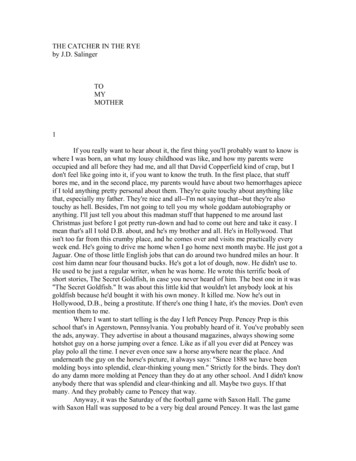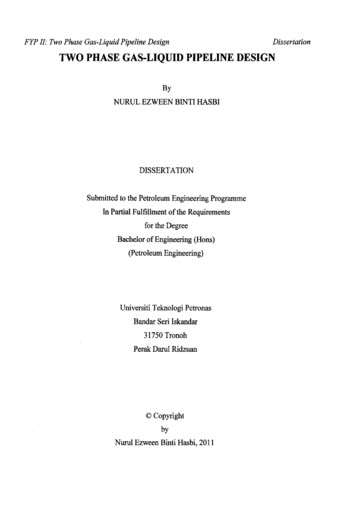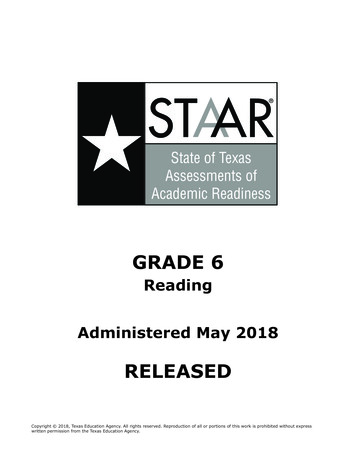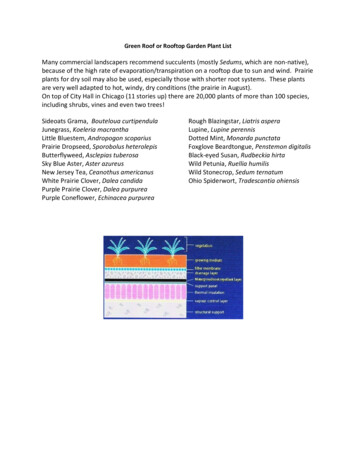
Transcription
SamplePrestwick HouseMultiple CriticalPerspectives Prestwick HouseTeaching J.D. Salinger’sThe Catcher in the RyefromMultiple Critical Perspectives Click hereto learn moreabout thisMultiple CriticalPerspectives! Click hereto find moreClassroom Resourcesfor this title! Prestwick HouseMore from Prestwick HouseLiteratureLiterary Touchstone ClassicsLiterature Teaching UnitsGrammar and WritingCollege and Career Readiness: WritingGrammar for WritingVocabularyVocabulary Power PlusVocabulary from Latin and Greek RootsReadingReading Informational TextsReading Literature
Multiple CriticalPerspectivesTeaching J.D. Salinger'sThe Catcher in the RyefromMultiple Critical Perspectives byStephanie Polukis
Multiple CriticalPerspectivesThe Catcher in the RyeGeneral Introduction to the WorkIntroduction to The Catcher in the RyeSinceThe Catcher in the Rye was published in 1951, the book has received mixed reviews. While sev-eral critics commend Salinger’s thorough development of the narrator, the realistic use of vernacularin the narration, and the accurate portrayal of post-World War II teenage life, others feel that the novel isperverse and immoral. In fact, The Catcher in the Rye was on the public school’s banned book list for itsuse of profane language, depiction of underage drinking, and sexual allusions. However, regardless of thechallenges to the novel, the book was a New York Times Bestseller for thirty weeks, and remains popularin the twenty-first century.While the novel in its present form is roughly 214 pages long, the story evolved from short storiespublished by J.D. Salinger in the 1940s. “I’m Crazy,” published by Collier’s magazine in 1945, developedinto the conversation with Mr. Spencer in Chapter 2 and Holden’s visit to Phoebe in Chapters 22 and 23.While the story features Holden, the Spencers, and Phoebe, it also includes Jeanette—the housekeeper—and Viola—Holden’s youngest sister, who have both been omitted from the novel. Salinger’s “Slight Rebellion Off Madison,” published in the New Yorker in 1946, developed into Chapters 17 and 19 of the novel,and it featured early prototypes of Sally Hayes, and Carl Luce. In addition, The Catcher in the Rye wasoriginally to be published as a 99 page novella in 1946, but Salinger backed out of the agreement with thepublishing company and published the book as a full-length novel in 1951.Even though the book is now more than fifty years old, its universal motifs of teenage angst, suspicion of authority, and rebellion against social convention still resonate with modern-day readers. Thebook has been translated into several different languages and is still one of the top books taught in highschools nationwide.6Pr e s t w i c kHo u s e,In c.
The Catcher in the RyeMultiple CriticalPerspectivesPsychoanalytic Theory Appliedto The Catcher in the RyeNotes on the Psychoanalytic TheoryThe term “psychological”(also “psychoanalytical” or “FreudianTheory”) seems to encompass two almost contradictory criticaltheories. The first focuses on the text itself, with no regard to outsideinfluences; the second focuses on the author of the text.According to the first view, reading and interpretation are limitedto the work itself. One will understand the work by examining conflicts, characters, dream sequences, and symbols. In this way, the psychoanalytic theory of literature is similar to the Formalist approach.One will further understand that a character’s outward behavior mightconflict with inner desires, or might reflect as-yet-undiscovered innerdesires.Main areas of study/points of criticism of the first view: There are strong Oedipal connotations in this theory: the son’sdesire for his mother, the father’s envy of the son and rivalryfor the mother’s attention, the daughter’s desire for her father,the mother’s envy of the daughter and rivalry for the father’sattention. Of course, these all operate on a subconscious levelto avoid breaking a serious social more. There is an emphasis on the meaning of dreams. This is because psychoanalytic theory asserts that it is in dreams that aperson’s subconscious desires are revealed. What a person cannot express or do because of social rules will be expressed andaccomplished in dreams, where there are no social rules. Mostof the time, people are not even aware what it is they secretlydesire until their subconscious goes unchecked in sleep.Pr e s t w i c kHo u s e,In c.15
Multiple CriticalPerspectivesThe Catcher in the RyeActivity OneEvaluating the Latent Desires, Fears, and Values Revealed in Holden’s Digressions1. Copy and distribute the handout: The Catcher in the Rye: Psychoanalytic/Freudian Theory—ActivityOne: Latent Desires, Fears, and Values Revealed in Holden’s Digressions2. Divide the class into small groups and assigned each group (or allow each to choose) one of thefollowing: Holden’s description of Allie’s baseball mitt and of Allie’s death (Chapter 5) Holden’s memories of Phoebe and Allie (Chapter 10) Holden’s childhood friendship with Jane Gallagher (Chapter 11) Holden’s dislike of Jesus’ disciples and his discussion with Arthur Childs (Chapter 14) Holden’s flashback of the fight between James Castle and Phil Stabile (Chapter 22)3. Have each group answer the questions on the worksheet, using thorough explanations as well asexamples from the text.4.20Reconvene the class and have students present their findings to the other groups.Pr e s t w i c kHo u s e,In c.
The Catcher in the RyeMultiple CriticalPerspectivesFeminist Theory Appliedto The Catcher in the RyeNotes on the Feminist TheoryFeminism is an evolving philosophy,and its application in litera-ture is a relatively new area of study. The basis of the movement,both in literature and society, is that the Western world is fundamentally patriarchal (i.e., created by men, ruled by men, viewed throughthe eyes of men, and judged by men).In the 1960s, the feminist movement began to form a new approach to literary criticism. Of course, women had already been writing and publishing for centuries, but the 1960s saw the rise of a feminist literary theory. Until then, the works of female writers (or worksabout females) were examined by the same standards as those bymale writers (and about men). Women were thought to be less intelligent than men, at least in part because they generally received lessformal education, and many women accepted that judgment. It wasnot until the feminist movement was well under way that womenbegan examining old texts, reevaluating the portrayal of women inliterature, and writing new works to fit the developing concept of the“modern woman.”The feminist approach is based on finding and exposing suggestions of misogyny (negative attitudes toward women) in literature.Feminists are interested in exposing the undervaluing of women inliterature that has long been accepted as the norm by both men andwomen. They have even dissected many words in Western languagesthat reflect a patriarchal worldview. Arguing that the past millenniain the West have been dominated by men—whether the politiciansin power or the historians recording it all—feminist critics believethat Western literature reflects a masculine bias, and, consequently,represents an inaccurate and potentially harmful image of women. Inorder to repair this image and achieve balance, they insist that worksby and about women be added to the literary canon and read from afeminist perspective.Pr e s t w i c kHo u s e,In c.27
The Catcher in the RyeMultiple CriticalPerspectivesActivity OneAnalyzing How Telling the Story from A Female Perspective Alters A Scene1.Have students reread the following passages independently or in small groups: Chapter 8, from “Old Mrs. Morrow didn’t say anything ” until “No kidding. Hours.” Chapter 11, from “I remember this one afternoon ” until “Some girls you never practically figureout what’s the matter.” Chapter 17, from “You can’t just do something like that ” until “I was pretty goddam fed up bythat time.”2. Depending on the time length of your class, ask students to either re-write the passage from theperspective of the female character (a. Mrs. Morrow, b. Jane Gallagher, c. Sally Hayes) or list ways inwhich the scene would be different if narrated by a woman.3.Ask the students to answer the following questions: How does narrating the scene from a female perspective alter the story? How does narrating the scene from a female perspective alter the portrayal of the characters involved? Is there any new information revealed about the events described? Does this new perspective of events reveal any masculine bias in Holden’s narration? If so, what? Does this new perspective refute any stereotypes about women that Holden may have made in hisnarration?4.Reconvene as a class and discuss the questions.Pr e s t w i c kHo u s e,In c.31
The Catcher in the RyeMultiple CriticalPerspectivesMarxist Theory Appliedto The Catcher in the RyeNotes on the Marxist TheoryTheMarxistapproach to literatureis based on the philosophyof Karl Marx, a German philosopher and economist. His majorargument was that whoever controlled the means of production in society controlled the society—whoever owned the factories “owned”the culture. This idea is called “dialectical materialism,” and Marxfelt that the history of the world was leading toward a communist society. From his point of view, the means of production (i.e., the basisof power in society) would be placed in the hands of the masses, whoactually operated them, not in the hands of those few who ownedthem. It was a perverted version of this philosophy that was at theheart of the Soviet Union. Marxism was also the rallying cry of thepoor and oppressed all over the world.To read a work from a Marxist perspective, one must understandthat Marxism asserts that literature is a reflection of culture, and thatculture can be affected by literature (Marxists believed literaturecould instigate revolution). Marxism is linked to Freudian theory byits concentration on the subconscious—Freud dealt with the individual subconscious, while Marx dealt with the political subconscious.Marx believed that oppression exists in the political subconscious ofa society—social pecking orders are inherent to any group of people.Four main areas of study: economic power materialism versus spirituality class conflict art, literature, and ideologiesPr e s t w i c kHo u s e,In c.37
The Catcher in the RyeMultiple CriticalPerspectivesActivity OneExamining How Dialect Conveys Class Oppression in the Novel1.Divide the class into small groups.2. Assign each group (or allow each to choose) a character below, and have them re-read the corresponding passages: Horowitz (Chapter 12, beginning with “Hey, Horowitz,” and ending with “Everything you saidmade him sore.”) Sunny (Chapter 13, beginning with, “How do you do” and ending with “So long.”) Maurice (Chapter 14, beginning with, “What’s the matter?” and ending with “All I felt was this terrific punch in my stomach.”) Mr. Antolini (Chapter 24, beginning with, “Mr. and Mrs. Antolini had this very swanky apartment,”and ending with, “I can’t stand it.”) Sally Hayes (Chapter 15, beginning with “Anyway, I gave her a buzz,” and ending with, “but shewas very good-looking”; Chapter 17, beginning with, “Finally, old Sally started coming up thestairs,” and ending with, “God I’m a madman”; and Chapter 20, beginning with, “Then there was adifferent voice,” and ending with “When I’m drunk, I’m a madman.”) Mrs. Morrow (Chapter 8, beginning with, “All of a sudden, this lady got on at Trenton,” and endingwith, “even if I was desperate.”)3. Have the groups analyze the dialogue of their assigned character and make a list of what words orphrases reveal the character’s class status and why.4. Have them also note the impression being created by the representation of each character’s dialect.What trait is being most emphasized in each character’s speech?5. Finally, have students note the techniques Salinger uses to recreate each character’s dialect (e.g., italicizing individual syllables, apostrophes to indicate dropped letters, etc.).Pr e s t w i c kHo u s e,In c.41
6 P r e s t w i c k Ho u s e, in c. Multiple Critical Perspectives The Catcher in the Rye General Introduction to the Work Introduction to The Catcher in the Rye S ince The Ca T C h e r in T he rye was published in 1951, the book has received mixed reviews. While sev-eral critics commend Salinger’s thorough dev










